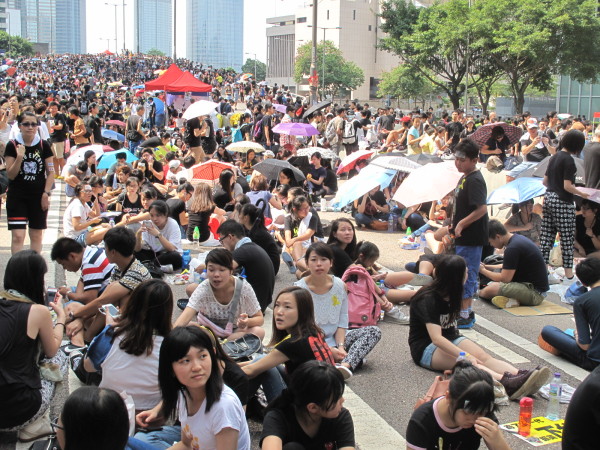Hong Kong’s Occupy Central protests have reached a stage that could be called, ‘in the doldrums’, at least if you judge by the few hundred remaining day-time protesters and the lacklustre news reportage as everyone repeats the few press announcements that have circulated around the same themes since last weekend. But even doldrums have a function, in fact they are a precurser to an amazing amount of climatic activity. Pondering on the doldrums as an expression from maritime usage, referring to those parts of the Atlantic Ocean and the Pacific Ocean affected by the Inter-tropical Convergence Zone, a low-pressure area around the equator where the prevailing winds are calm, with sudden storms, and light unpredictable winds. The emotional climate among the people of Hong Kong relates well to that phenomenon’s dynamics.
The energies are in reality seeking a way through and one of the most interesting so far is that proposed on David Webb’s website (*) which is titled: “The way out” (substantial extract follows).
The Way Out
In a 12th-hour media conference last Thursday (2-Oct-2014), with massive crowds in Admiralty calling for his resignation after the tear gas and riot police were deployed the previous Sunday, the Chief Executive appointed the Chief Secretary to meet with the protesters and discuss constitutional development. But he said:
“We should work within the framework of the decision of the NPCSC and so on, so forth. Only do we follow the provisions of the Basic Law and the decisions of the NPCSC can we have universal suffrage in 2017.”
Now to recap, on 6-Apr-2004 during the debate over whether we could have universal suffrage in 2007, the NPCSC issued an interpretation of the Basic Law laying out the “five-step method” for future reforms. It said:
The Chief Executive of the HKSAR shall make a report to the NPCSC as regards whether there is a need to make an amendment;
The NPCSC shall, in accordance with the provisions of Article 45 of the Basic Law make a determination in light of the actual situation in the HKSAR and in accordance with the principle of gradual and orderly progress;
The bill on the amendment shall be introduced by the HKSAR Government into the Legislative Council (where it requires a two-thirds majority to pass);
The Chief Executive shall then approve (or reject) the amendent;
Finally the NPCSC shall approve (or reject) the amendment.
Article 45 of the Basic Law says in relevant part:
“The method for selecting the Chief Executive shall be specified in the light of the actual situation in the Hong Kong Special Administrative Region and in accordance with the principle of gradual and orderly progress. The ultimate aim is the selection of the Chief Executive by universal suffrage upon nomination by a broadly representative nominating committee in accordance with democratic procedures.”
But when you read the CE’s report to the NPCSC issued on 15-Jul-2014, it is quite evident that the current “actual situation in HK” has either changed since then, or he failed to get it right the first time. In fact, the report was so indecisive as to offer no advice to the NPCSC at all, even if they were seeking it, and Beijing came down hard with its own decision.
That introduction takes those interested in a solution to one that should becalm all sides, to quote again:
The democratic option
The talks scheduled for 4pm on Friday [October 10, 2014] between the Chief Secretary and the protest leaders (or at least, the Federation of Students) will go nowhere unless the governments here and in Beijing are willing to accept that the “actual situation in HK” has either changed or was not accurately reflected in the July report, and that the decision of the NPCSC was therefore made on faulty information.
Following the 5-step framework laid down by the NPCSC in 2004, the CE should send a new or “supplemental” report to the NPCSC with a clear recommendation for a formula that would be acceptable to the majority of the public. For it to be acceptable, it has to walk and talk like democracy and give every candidate who meets the Basic Law criteria (aged over 40, resident for 20 years, Chinese without a foreign passport), a fair chance to be nominated and elected.
The recommendation does not need to go outside the Basic Law. It can continue to use a nominating committee rather than direct civic nomination, but it does need to contain a reasonable threshold for any candidate to be nominated by the 1200-member committee, such as the 12.5% used in 2012 and not the 50% majority proposed by the NPCSC in its latest decision. That’s not nomination, that’s pre-election.
The Chief Executive and Beijing have one last chance to take the moral high ground and regain the confidence of the HK people. By the CE making a fresh report, and the NPCSC making a fresh decision, they can show that the “two systems” model is alive and well, and that, just as HK is a laboratory for RMB internationalisation, it will be a laboratory for democratisation, with the rest of China to follow when it is ready.
This is certainly a way forward, for both (every) side.
For the full article see:
http://webb-site.com/articles/twooptions.asp
A video of Hong Kong protests October 2, 2014, taken with a drone by Nero Chan:
https://www.youtube.com/watch?v=daB4npvO36w






